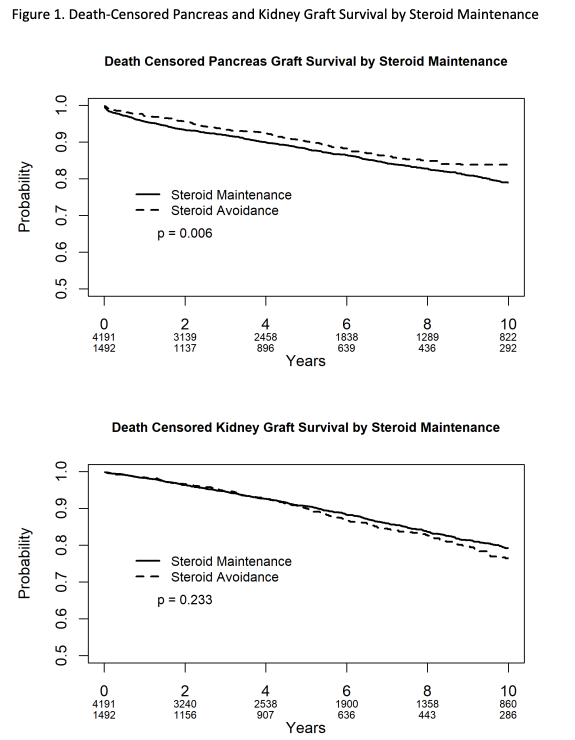Long-term outcomes in primary simultaneous kidney and pancreas recipients under steroid avoidance in the United States
Adam Cerise2, Scott Jackson3, Raja Kandaswamy2, Samy Riad1.
1Nephrology , University of Minnesota, Minneapolis, MN, United States; 2Surgery , University of Minnesota, Minneapolis, MN, United States; 3Complex Care Analytics , University of Minnesota, Minneapolis, MN, United States
Background: Steroid avoidance in kidney transplantation has been proven non-inferior. Data on steroid avoidance in simultaneous pancreas-kidney (SPK) is scant.
Methods: We utilized the Scientific Registry of Transplant Recipients (SRTR) between 2000 and 2020 we studied all primary crossmatch negative SPK recipients (N=5683) who received anti-thymocyte globulin for induction and were discharged alive on tacrolimus and mycophenolate with or without steroid maintenance. Recipients were grouped according to steroid use into two groups: steroid maintenance n=4191 and steroid avoidance n=1492. Kaplan-Meier curves with generated for Recipient and allografts survival according to steroid maintenance censored at 10 years. Predictors for recipient and grafts survival were examined using Cox proportional Hazards. Models were adjusted for age, BMI, ethnicity, diabetes type, HLA-antigen mismatches, cold ischemia time, transplant era, preemptive transplantation, and PDRI with the transplant center included as a random effect.
Results: Steroid avoidance gained popularity over the years, accounting for over one fourth of the studied cohort. One-year acute rejection rates by steroid avoidance were comparable for kidney (8.6 vs. 9%, P= 0.783, however pancreas rejection rate was lower in the steroid avoidance group (7.9 vs. 10%. P=0.035). In the Kaplan-Meier analysis for the pancreas death-censored graft survival (DCGS), steroid avoidance was associated with better pancreas graft survival (log-rank p =0.006). The kidney DCGS did not vary between groups (log-rank p=0.233). In the multivariable models, steroid avoidance did not influence recipient (LLCI, aHR, ULCI) (0.94, 1.15,1.39), death-censored pancreas graft survival (0.75, 0.93, 1.16) or kidney (0.95, 1.18, 1.45) compared to recipients on steroid maintenance.

Conclusion: After multivariable adjustment for recipient and grafts characteristics, steroid avoidance is associated with similar patient, pancreas and kidney grafts outcomes when compared with steroid maintenance in SPK recipients following r-ATG induction and tacrolimus plus mycophenolate maintenance.
The data reported here have been supplied by the Hennepin Healthcare Research Institute (HHRI) as the contractor for the Scientific Registry of Transplant Recipients (SRTR). The interpretation and reporting of these data are the responsibility of the author(s) and in no way should be seen as an official policy of or interpretation by the SRTR or the U.S. Government.
